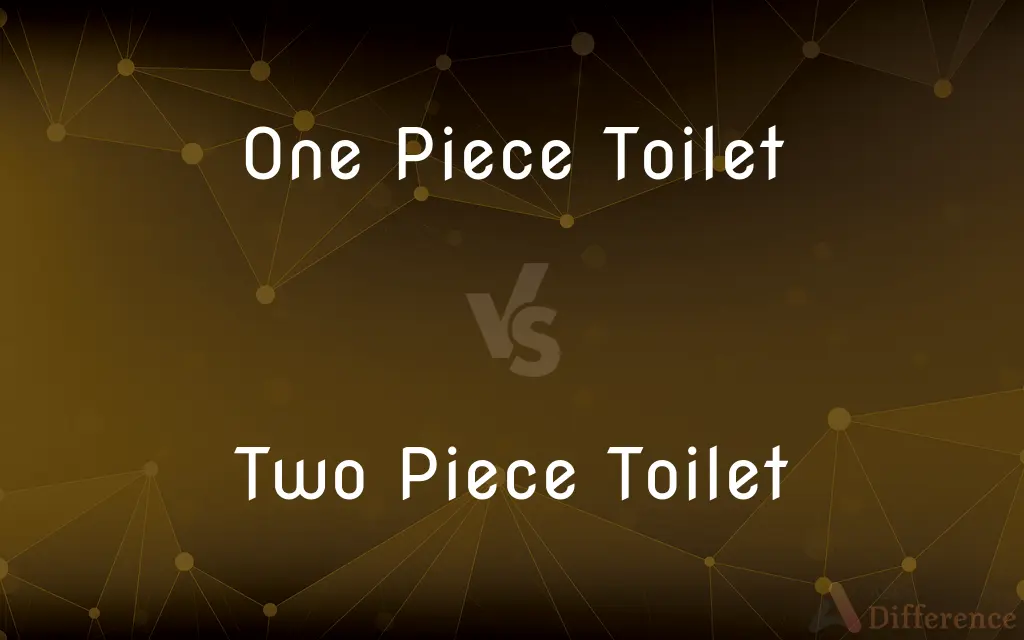One Piece Toilet vs. Two Piece Toilet — What's the Difference?
Edited by Tayyaba Rehman — By Fiza Rafique — Published on September 18, 2024
One-piece toilets feature an integrated tank and bowl design, offering sleek aesthetics and easier cleaning, while two-piece toilets have a separate tank and bowl, making them more traditional and often less expensive.

Difference Between One Piece Toilet and Two Piece Toilet
Table of Contents
ADVERTISEMENT
Key Differences
One-piece toilets are designed with the tank and bowl fused into a single unit, which not only provides a modern and sleek look but also minimizes the crevices where bacteria and grime can accumulate, making them easier to clean. On the other hand, two-piece toilets have a separate tank and bowl that are bolted together during installation, a design that has been traditional and widely used for many years. This separation can make cleaning more challenging due to the additional seams and crevices.
The installation process of a one-piece toilet is generally more straightforward due to its integrated design, making it a heavier but simpler unit to install. This is because there are no separate parts to assemble other than connecting the toilet to the plumbing. In contrast, two-piece toilets may require more effort in installation since the tank and bowl need to be assembled and then connected to the plumbing, although the separate pieces can be easier to handle individually due to their lighter weight.
From a cost perspective, one-piece toilets tend to be more expensive due to their sleek design and the complex manufacturing process required to create the integrated structure. Two-piece toilets, on the other hand, are often less costly, making them a more budget-friendly option for many homeowners. The difference in cost can also reflect in the repair and replacement parts, with one-piece models potentially having higher expenses associated with maintenance.
Durability is another aspect to consider; one-piece toilets often have fewer leaks and issues over time because they lack the gasket connection between the tank and bowl that can wear out in two-piece toilets. However, if a part of a two-piece toilet breaks, it may be easier and cheaper to replace just that part rather than the entire unit, as might be necessary with a one-piece toilet.
In terms of variety and customization, two-piece toilets offer more options in terms of tank and bowl configurations, which can be an advantage if you are looking for specific features or need to match certain dimensions in your bathroom space. One-piece toilets have less variability, but their modern designs can complement contemporary bathroom decors more effectively.
ADVERTISEMENT
Comparison Chart
Design
Integrated tank and bowl, sleek and modern
Separate tank and bowl, traditional
Cleaning
Easier due to fewer crevices
More challenging due to seams and crevices
Installation
Generally simpler but heavier to move
More steps but pieces are lighter to handle
Cost
Higher initial cost and potential repair costs
Generally more affordable, cheaper parts
Durability
Fewer leaks due to lack of tank-bowl gasket
Gasket can wear out but easier to replace parts
Variety
Limited customization options
More options in configurations
Compare with Definitions
One Piece Toilet
Generally more expensive due to the integrated manufacturing process.
Despite its higher price, the one-piece toilet's durability and style made it a worthwhile investment.
Two Piece Toilet
A traditional toilet design with a separate tank and bowl.
The two-piece toilet's classic design fit well with the bathroom's traditional theme.
One Piece Toilet
A toilet with an integrated tank and bowl, offering a sleek design.
The one-piece toilet's seamless design enhanced the bathroom's modern aesthetic.
Two Piece Toilet
Often more affordable, both in initial cost and for replacement parts.
Choosing a two-piece toilet allowed for staying within the bathroom remodel budget.
One Piece Toilet
Known for easier cleaning due to its minimal crevices.
Cleaning the one-piece toilet was quick, thanks to its smooth, joint-free surface.
Two Piece Toilet
The separate pieces can make handling and installation more manageable.
Transporting and installing the two-piece toilet was straightforward since the tank and bowl were carried separately.
One Piece Toilet
May be heavier and more challenging to maneuver during installation.
Installing the one-piece toilet was a two-person job due to its weight.
Two Piece Toilet
Provides a wider range of options for tank and bowl configurations.
The ability to mix and match the tank and bowl made the two-piece toilet a versatile choice for the renovation.
One Piece Toilet
Offers a contemporary look that complements modern bathroom designs.
The sleek lines of the one-piece toilet matched perfectly with the bathroom's contemporary decor.
Two Piece Toilet
More parts and seams can make cleaning more labor-intensive.
Cleaning around the tank and bowl junction of the two-piece toilet required extra effort.
Common Curiosities
Can one-piece toilets fit into small bathrooms?
Yes, one-piece toilets, with their compact design, are often suitable for smaller bathrooms.
Can I replace just the tank or bowl in a two-piece toilet?
Yes, one advantage of two-piece toilets is the ability to replace just the tank or bowl if needed.
Are there color options for both types of toilets?
Yes, both one-piece and two-piece toilets come in various colors to match bathroom decor.
How long do one-piece toilets last compared to two-piece?
Both can have long lifespans; durability often depends more on the brand and material quality than the design.
Is it easier to install a bidet on one type over the other?
Bidet installation is generally compatible with both types, depending on the specific bidet model and toilet design.
Are two-piece toilets more prone to leaks?
Two-piece toilets may have a higher risk of leaks at the tank-bowl junction over time, compared to one-piece models.
Can the height of the toilet be adjusted?
Toilet height is usually fixed, but both one-piece and two-piece toilets are available in different heights, including "comfort height" models.
Can two-piece toilets be upgraded more easily?
Two-piece toilets offer more flexibility for upgrades or replacements of individual parts.
Is the flushing performance different between the two?
Flushing performance generally depends on the flush mechanism rather than the toilet's design as one or two-piece.
Are one-piece toilets more environmentally friendly?
The efficiency and environmental impact depend more on the flush system and water usage than on the toilet's one or two-piece design.
Do one-piece toilets have fewer parts to maintain?
Yes, the integrated design means fewer components and potentially fewer maintenance issues.
Do one-piece toilets save water?
Both one and two-piece toilets can be designed to be water-efficient, depending on the model and flushing system.
Which type is better for commercial use?
Two-piece toilets are often preferred in commercial settings for their ease of maintenance and part replacement.
Do both types of toilets come in different flush types?
Yes, both one and two-piece toilets can feature various flush mechanisms, such as dual flush or gravity flush.
Is there a difference in warranty between the two types?
Warranty terms can vary by manufacturer and not necessarily by the toilet being one or two-piece.
Share Your Discovery

Previous Comparison
Pili vs. Fimbriae
Next Comparison
Humidity vs. Relative HumidityAuthor Spotlight
Written by
Fiza RafiqueFiza Rafique is a skilled content writer at AskDifference.com, where she meticulously refines and enhances written pieces. Drawing from her vast editorial expertise, Fiza ensures clarity, accuracy, and precision in every article. Passionate about language, she continually seeks to elevate the quality of content for readers worldwide.
Edited by
Tayyaba RehmanTayyaba Rehman is a distinguished writer, currently serving as a primary contributor to askdifference.com. As a researcher in semantics and etymology, Tayyaba's passion for the complexity of languages and their distinctions has found a perfect home on the platform. Tayyaba delves into the intricacies of language, distinguishing between commonly confused words and phrases, thereby providing clarity for readers worldwide.













































